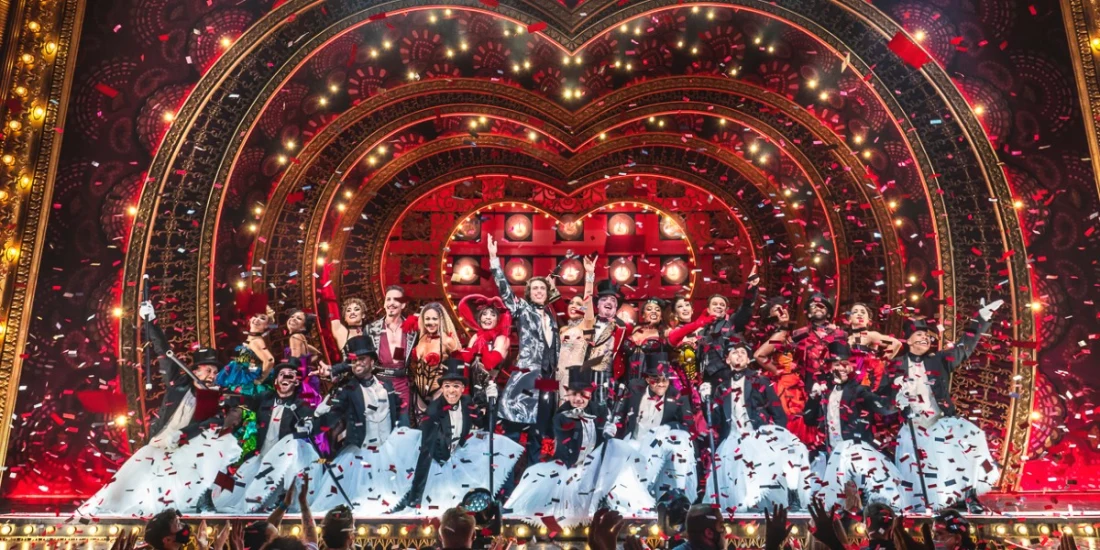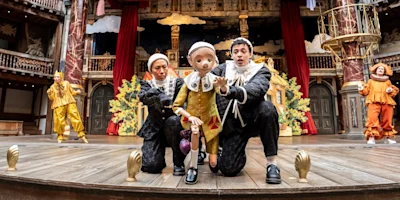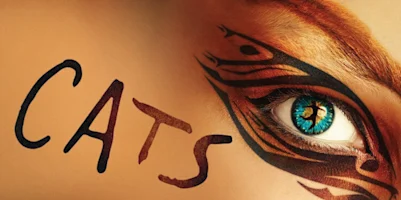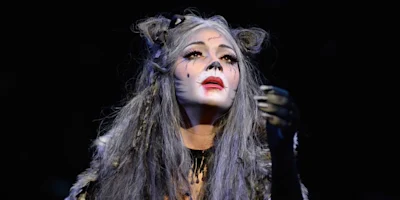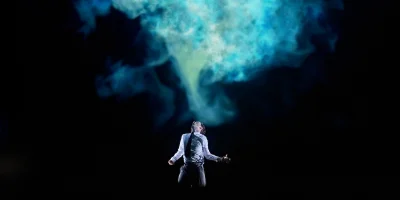
Here's how 19th-century French history inspired 'Moulin Rouge! The Musical'
Many elements of the award-winning show, from its title to its characters to its decor, are inspired by real people and places from a bygone era of France.
"Welcome to the Moulin Rouge!" That’s how cabaret owner Harold Zidler greets audiences arriving at Moulin Rouge! The Musical in London. And it’s potentially how the similarly named Charles Zidler also greeted patrons more than 100 years ago. Both Moulin Rouge! The Musical, and the 2001 Baz Luhrmann film, take their name from a real Parisian nightclub where can-can dance was born.
The main story of Moulin Rouge! The Musical is pure fiction: A writer and a showgirl fall into a forbidden romance that’s threatened by, among other things, a jealous Duke whose money keeps the club afloat. They also sing lots of contemporary pop songs that wouldn’t be written for another 100 years.
But Luhrmann and the musical’s creators did borrow from some actual French history to recreate the world of the Moulin Rouge for the musical. There’s plenty of can-can in the show, and a grand display of glitzy sets, costumes, and music that reflects the real cultural renaissance of late 19th-century France. Learn more about the social, artistic, and even medical history that’s reflected in the spectacular spectacular.
Book Moulin Rouge! The Musical tickets on London Theatre.
Turn-of-the-century Paris
The decade leading up to 1900 are known as the “fin de siècle” (literally translating to “end of the century”). These years fall smack in the middle of France’s Belle Époque (“Beautiful Epoch”), which stretched from the 1870s to the outbreak of World War I in 1914.
Those years were marked by prosperity: Lots of industrial, technological, scientific, and economic progress was made, and culture and the arts especially flourished. The year 1889 alone saw the creation of two Parisian landmarks: the Eiffel Tower and the Moulin Rouge, together representing a spirit of cultural progress and hope for Paris.
Ironically, though, the “spirit” of the fin de siècle, as history remembers it now, is marked by cynicism and boredom. A lot of people back then didn’t see the era’s new cultural advances as good; they saw them as signs of overindulgence that would lead to degeneracy. Moulin Rouge! The Musical captures the era in a much more positive light, remembering the fin de siècle as a time of “truth, beauty, freedom, and love” for those who chose to enjoy it.
“The malady of the century”
On the flip side of the wonders of the fin de siècle was the mal du siècle — the malady of the century, the then-common name for tuberculosis. And you might be surprised how often this disease shows up in musicals. Tuberculosis has been around since ancient times, but it reached epidemic status in Europe in the 19th century, just before the events of Moulin Rouge! The Musical. It was more commonly known as consumption back then and became known as the “disease of artists” because poets would romanticize the pale and melancholy look of people, women especially, with the disease. Consumption became associated with purity, and wealthy women would pale their faces to look like they had it.
All this seems especially unthinkable to us now, having gone through a pandemic. But we can still see references to it in some modern musicals. In Victor Hugo’s Les Misérables novel, Fantine dies from consumption, and her death is associated with ultimate purity and peace. This was replicated in the musical. Something similar happens in Moulin Rouge! The Musical, but we won’t spoil the plot.
The Moulin Rouge club
Moulin Rouge! The Musical (and the movie) takes plenty of license with its depiction of the titular club — all the events that take place in the story are fictional, and they definitely wouldn’t have been singing Elton John’s “Your Song” there at the turn of the 20th century. But we wouldn’t have the movie or musical at all if the club wasn’t so famous in its own right.
The real Moulin Rouge opened in 1889, and the name literally translates to “red windmill,” a nod to the iconic red windmill on its roof that’s been replicated for the movie and musical. The giant elephant statue in the Moulin Rouge! adaptations is also in the real club’s garden.
People of all backgrounds mingled at the Moulin Rouge — the surrounding Montmarte district was populated with fashionable yet middling-class bohemians, but the very rich would also come there to see, essentially, how the other half lived. The place became famous as the birthplace of can-can dancing (more on that below) and still operates today, hosting dance revues for tourists. In 2019, the Moulin Rouge celebrated its 130th anniversary.
Because you can-can-can
You can-can do the can-can — if you have a lot of stamina! The French dance style is said to have originated in the 1840s at the actual Moulin Rouge nightclub, and though its signature high kicks certainly look fun, they’re physically demanding to perform.
But back when the can-can first came onto the dance scene, plenty of people didn’t find it fun or respectable, no matter how strong those dancers were. Those high kicks were deliberately revealing as a way of challenging the restrictive social norms placed on women at the time. Naturally, Victorian elites found the dance improper, so they coined it “can-can” after a French slang word for gossip or scandal.
Ironically, though, the can-can originated out of the quadrille, a perfectly proper dance performed by couples at balls. That dance also includes high-energy kicks, but the difference was that ladies at balls wore full-coverage undergarments beneath their ruffled skirts. At the Moulin Rouge, they did not. But nonetheless, once the Moulin Rouge popularized the dance, cabarets popped up all over Paris in the late 1800s and cemented the can-can as an international phenomenon that drew in tons of audiences.
Historical characters
Some of the characters are loosely based on people from the real Moulin Rouge’s history. A man named Charles Zidler was one of the club’s co-founders (alongside Joseph Oller), and that’s where Harold Zidler, the club owner in the Moulin Rouge! musical and movie, got his name.
There’s also Toulouse-Lautrec, who in the play is one of the bohemian artists that Christian meets upon his arrival to Paris, and who helps him co-write a musical to be performed at the club. In real life, Henri de Toulouse-Lautrec was an artist who created multiple Moulin Rouge-related works of art. Besides his promotional posters for the club, his most famous artwork is At the Moulin Rouge, a painting of patrons at the club’s cabaret tables that now hangs in the Art Institute of Chicago.
The bohemian lifestyle
In the mid-19th century, shortly before the events of Moulin Rouge! The Musical, the French coined the term “bohemian” as we know it today. The term is derived from Bohemia, a region in modern-day Czechia from where the Romani people were mistakenly thought to have traveled to France.
The Romani people were outsiders in French society, though it didn’t bother them. Adherents to the bohemian lifestyle were also outsiders — people from all walks of life who enjoyed the cultural progress of the era and didn’t live a traditional “proper” lifestyle. These perceived similarities between the groups are how the term “bohemian” came to be associated with the writers, artists, and musicians like those in Moulin Rouge! The Musical — including the writer Christian, the main character.
Besides focusing on unconventional artistic, literary, and spiritual pursuits, bohemians often also held unpopular political, social, and spiritual beliefs. They usually didn’t settle down in any one place, and many practiced voluntary poverty and lived with few possessions. In contrast, there was also a small class of bohemians, known in French as the haute bohème, who held bohemian beliefs and occupations but were wealthier. Moulin Rouge! The Musical best sums up what they all had in common, though — an appreciation for truth, beauty, freedom, and love.
Frequently asked questions
What is Moulin Rouge! The Musical about?
Freedom, beauty, truth, and love are the bohemian way! The hit film takes to the stage with all-new songs seamlessly blended with the classic medleys. This dazzling production reaches the West End after a hit Broadway debut in a stunning spectacular that brings all the magic of the Moulin Rouge cabaret to life.
How long is Moulin Rouge! The Musical?
The running time of Moulin Rouge! The Musical is 2hr 45min. Incl. 1 interval.
Where is Moulin Rouge! The Musical playing?
Moulin Rouge! The Musical is playing at Piccadilly Theatre. The theatre is located at 16 Denman Street, London, W1D 7DY.
What's the age requirement for Moulin Rouge! The Musical?
The recommended age for Moulin Rouge! The Musical is Ages 12+..
How do you book tickets for Moulin Rouge! The Musical?
Book tickets for Moulin Rouge! The Musical on London Theatre.
What are the songs in 'Moulin Rouge'?
Several popular hits are featured in Moulin Rouge, including “Rolling in the Deep,” “Lady Marmalade,” and “Shut Up and Dance.” The show features 70 pop songs in total. Read our complete song guide to Moulin Rouge.
Who wrote 'Moulin Rouge'?
John Logan adapted Moulin Rouge for the stage, weaving together popular songs from various artists. Drawing inspiration from Baz Luhrmann's film, the musical captures its distinctive style while introducing creative narrative elements.
Who directed 'Moulin Rouge'?
Alex Timbers directed the stage adaptation of Moulin Rouge! At the 2020 Tony Awards, Timbers won Best Direction of a Musical for his work on the production.
Is 'Moulin Rouge' appropriate for kids?
Moulin Rouge can be enjoyed by people of all ages but is most suitable for children over the age of 12. Under 16-year-olds must be accompanied by an adult.
Is 'Moulin Rouge' good?
The stage adaptation of Baz Luhrmann’s Moulin Rouge! is a wildly entertaining night at the theatre. Read our four-star review of Moulin Rouge.
Is Moulin Rouge: The Musical! the same as the film?
Moulin Rouge! The Musical remains faithful to the iconic 2001 film by Baz Luhrmann, following the same story. Many of the best-known songs from the movie are still in the stage adaptation, with some new additions.
Originally published on
